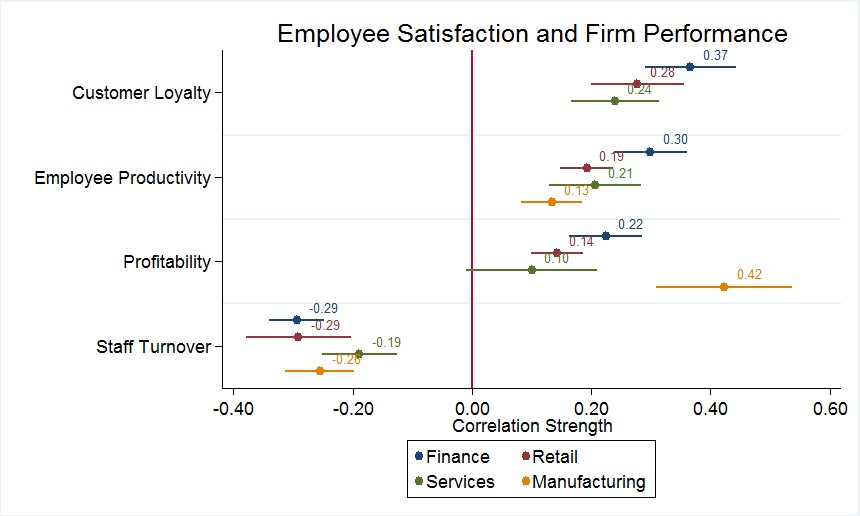How wellbeing impacts business, and differences between retail, manufacturing, finance, and services
This week’s guest blog comes from Christian Krekel, a Research Fellow at the Centre for Economic Performance, London School of Economics, working with George Ward from MIT Sloan and Jan-Emmanuel De Neve from Oxford University to analyse the relationship between employee wellbeing, productivity, and firm performance.
Employee wellbeing is an important goal in itself. A growing number of companies are investing in it, and there is a fast-growing number of firms selling products related to employee wellbeing. But does investing into higher employee wellbeing also lead to higher employee productivity, and ultimately, tangible benefits on the bottom line of business? Experiments like this one, for example, suggest that the answer to this question is ‘yes’. Systematic evidence, however, is largely missing.
To answer this question systematically, we collaborated with the Gallup Organization, and looked into its exclusive client database. Gallup has been gathering data on employee wellbeing, alongside employee productivity and firm performance outcomes, since the mid-1990s. We conducted a meta-analysis of 339 independent studies accumulated by Gallup, including the wellbeing and productivity of 1,882,131 employees and the performance of 82,248 business units, originating from 230 independent organisations across 49 industries in 73 countries.
Higher employee wellbeing is associated with higher productivity and firm performance
Our findings (highlighted in the figure below) show correlations between: employee wellbeing (measured as employees’ satisfaction with the firm as a place to work) and employee productivity/firm performance, taken across all industries and regions.
Figure 1: Correlation Between Employee Satisfaction, Productivity, and Firm Performance
(Gallup Client Database, 95% Confidence Intervals)

Notes: The figure plots adjusted average correlation coefficients between employee satisfaction and different performance outcomes originating from a meta-analysis of 339 independent studies that include observations on the wellbeing of 1,882,131 employees and performance of 82,248 business units. See Krekel et al. (2019) for more details.
- Employee satisfaction is positively associated with customer loyalty and negatively with staff turnover.
- The correlation with employee productivity is positive and strong.
- Importantly, higher customer loyalty and employee productivity, as well as lower staff turnover, are also reflected in higher business profitability, as evidenced by a moderate, positive correlation between employee satisfaction and profitability.
Some differences between industries, little between regions
Correlations differ somewhat by industry. Figure 2 shows true score correlations between employee wellbeing, productivity, and firm performance by industry, distinguishing finance, retail, services, and manufacturing sectors.
Figure 2: Correlation Between Employee Satisfaction, Productivity, and Firm Performance, by Industry
(Gallup Client Database, 95% Confidence Intervals)

Notes: The figure plots adjusted average correlation coefficients between employee satisfaction and different performance outcomes, by industry, originating from a meta-analysis of 339 independent studies that include observations on the wellbeing of 1,882,131 employees and performance of 82,248 business units. See Krekel et al. (2019) for more details.
For most outcomes – customer loyalty, staff turnover, and employee productivity – employee satisfaction is most important in finance, followed by retail, and then closely, by services.
- Finance: the correlation between employee satisfaction and business unit profitability appears to be somewhat stronger in the finance industry than in other industries, except manufacturing.
- Manufacturing: we find that employee satisfaction has the weakest correlation with employee productivity but the strongest with business unit profitability amongst all industry sectors.
Note, however, that 95% confidence bands between industries are largely overlapping, pointing towards the universal importance of employee wellbeing across industries.
One reason for the particularly strong link between wellbeing and productivity in the finance industry may have something to do with the working conditions in that sector, in particular relatively higher stress and lower work-life balance, which potentially outweigh positive benefits of higher pay.
This suggests that there is more room in the finance industry for employee wellbeing to unlock positive productivity outcomes than in other sectors. Manufacturing is highly focused on process efficiency and safety as primary metrics within plants, which relate directly to costs.
Employee wellbeing also seems to pay off on the bottom line of business: Edmans (2011, 2012) studies the relationship between employee satisfaction and long-run stock market returns using a value-weighted portfolio of the “100 Best Companies to Work for in America”. The author shows that, during the period 1984 to 2011, these companies had between 2.3 and 3.8 per cent higher returns than industry average.
More measurement of wellbeing would yield even more insight
The work presented here is suggestive of a strong, positive correlation between employee wellbeing, productivity, and firm performance. The evidence base is steadily mounting that this correlation is in fact a causal relationship (running from wellbeing to productivity). More field experiments, however, are needed to make this case clear-cut.
This calls for a consistent measurement of employee wellbeing in firms, alongside productivity and firm performance outcomes. Interventions aimed at raising productivity should target the key drivers of wellbeing, including social relationships at work, making jobs more interesting, and improving work-life balance6.
They should be rigorously evaluated (ideally by means of randomised controlled trials), and costs should be reported upon to identify the most cost-effective ways of raising employee wellbeing, productivity, and ultimately, firm performance.
There is a strong business case for promoting the wellbeing of workers.
